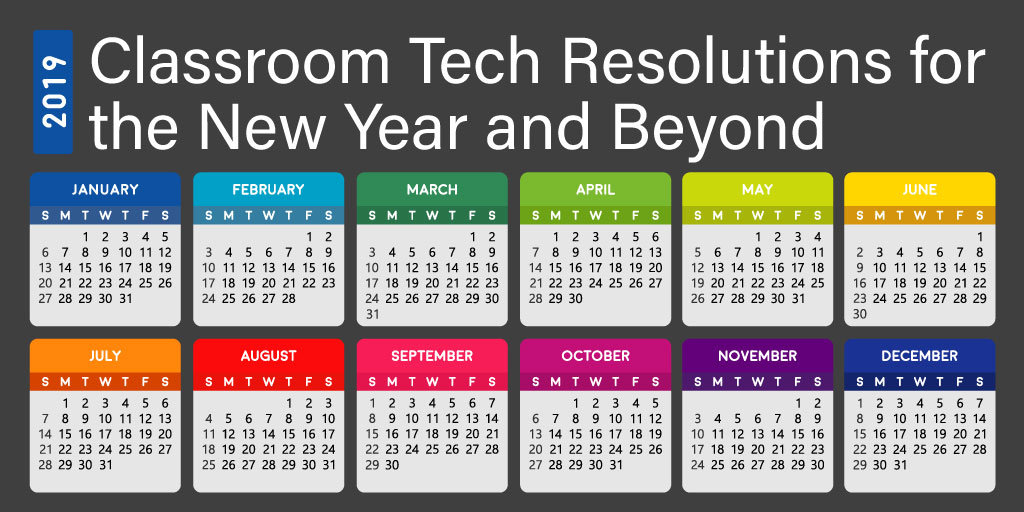
As each new year starts, we dedicate ourselves to becoming better than what we were the previous year. Maybe it is to lose weight, be more productive, sleep more, stick to our lists, or simply to become more organized with technology. After a few months though, that spark diminishes and we find ourselves back to the same routine.
Last year, I changed that routine and dedicated one technology resolution for each month of the year that carried me throughout the entire year with success. Take these 12 suggestions I accomplished each month and ignite the spark for how you use technology in your classroom. These monthly resolutions can be done in any order:
- January: Learn one new feature of a technology tool each month, or go even further and learn one new technology tool each month. While I belong to a multitude of educational technology blogs and groups, I tend to turn to the same few when I want to learn something new. John Sowash and Kasey Bell provide various Google Apps for Education updates that I often turn to. Additionally, Richard Byrne has an excellent blog full of free educational technology resources that are always worthwhile.
- February: Listen more—to podcasts, that is. A podcast is basically on-demand radio and can be played during your commute, on the treadmill, or while walking your dog. Listening to podcasts on education can give you many ideas for your classroom. Podcasts can be broadcast through apps such as Apple Podcasts (for iPhones), Google Podcasts (for Android), and Stitcher (on your phone or computer). Here are some interesting ones you can search for using the apps mentioned above:
- Chromebook Classroom Podcast (various Chromebook topics for instruction)
- Ted Talks Daily
- Check This Out (focused on educational technology)
- Teachers on Fire (interviews with various educators)
- Cult of Pedagogy (research-based classroom strategies)
- The Podcast History of Our World
- #edchat Radio (as well as their weekly Twitter chat)
- Wow in the World (science podcast for kids)
- Science Underground (lesson ideas that regularly align with NGSS standards)
- March: Find (and use!) a tool that helps you to organize your daily routines. One tool I use on a daily basis is Google Keep. Setting reminders for important events, creating lists of things to get done for the day, and using my voice to input a note that I can add into a Google Doc or Google Slides later in the day helps me to stay organized and on top of my daily tasks so I no longer forget any important details.
- April: Say or do something positive every day. This can simply happen in the hallway to a colleague, in your classroom to your students, or by creating badges for students using tools such as Class Badges or through Google Drawings.
- May: Get organized and declutter your email. I often receive over 100 emails a day, which can become a mess if I don’t organize from the start. I initially set up an organizational routine that has helped me day by day in managing my abundance of emails. I first created various folders to house emails that I needed to keep—my Gmail lets me set up tabs for primary, social, and promotions, which allows for additional organization. I also set up filters so certain emails are directed to either automatically be sent to a folder or starred as important. I make sure to unsubscribe to unwanted emails to eliminate additional clutter of my inbox. Plus, I use my Google calendar for events and Google Keep for timely reminders instead of keeping my email in my inbox. On a daily basis, I set aside 15–25 minutes to take care of email, and the end of the school year to review what needs to stay and what needs to go in my email folders.
- June: Apply for an EdTech grant. Start small with a local organization or company that donates funds to education. Many local companies must set aside a certain dollar amount to education on a yearly basis. If you are looking for a larger grant, consider checking Tech & Learning and THE Journal to see what’s available.
- July: Go paperless. Get help with funding through DonorsChoose.org for technology in your classroom to achieve that goal. District leaders and IT administrators can now submit their technology guidelines to DonorsChoose.org to incorporate into the teacher project creation process. After the guidelines are added, teachers can shop with various technology vendors and see the district’s recommended technology, technology items, and various brands to avoid.
- August: Build connections outside the walls of your classroom. There is an abundance of resources to connect your students to educational programs that will enrich your curriculum. Skype in the Classroom, Exploring by the Seat of Your Pants, CILC, and Google+ Connected Classrooms provide amazing experiences for your students that they wouldn’t be able to get simply from an online book or website.
- September: Use technology to communicate to parents. Let them know about the amazing things that are going on in your classroom. Products like Bloomz, Remind, Seesaw, and ClassTag function in similar ways to provide teachers a means of sharing classroom information, student work, images, video, and quick text messages to keep parents in the loop with class happenings.
- October: Give students ownership and let them have a voice in their learning. Create a website or a simple Google drawing with project choices in your project-based learning classroom. Have students participate in the creation of the scoring rubric that you would provide to your students. Survey them to get feedback on lessons, activities, and projects you do in class.
- November: Mix up your teaching methods and try something new. Being a member of ISTE has awarded me the opportunity to participate in an Artificial Intelligence Explorations and Their Practical Use in Schools course free of charge (a $299 value) where I am exploring new ways of teaching using AI. Find something new and try it out—you never know what doors may open as a result.
- December: Share, share, share! Remember that what you do in your classroom is important and should be shared with others. Be sure to share and listen to other ideas as well. Tweet out your awesome events that are happening in your classroom.
Most importantly, take time for yourself! Keep things balanced—refresh, recharge, and remember you are important to your students.
What’s your tech resolution for 2019? Tell us in the comments below! And for more inspiration all year long, be sure to subscribe to the Educator blog.





